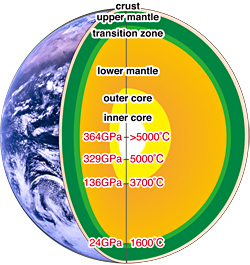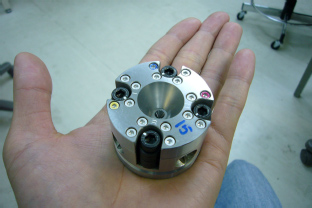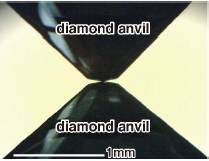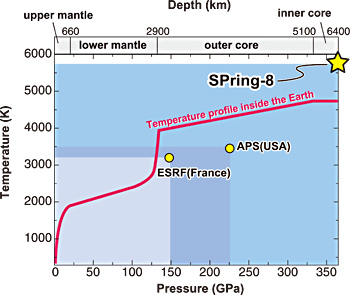



April 5, 2010
Japan Agency for Marine-Earth Science and Technology
Tokyo Institute of Technology
Japan Synchrotron Radiation Research Institute
Scientists Recreate Ultra-High Pressure and Temperature of Innermost Earth
- Allowing Synthesis of Mantle and Core Materials -
Overview
A team of scientists from the Institute for Research on Earth Evolution (IFREE) of the Japan Agency for Marine-Earth Science and Technology (JAMSTEC), Tokyo Institute of Technology (TOKYO TECH), and Japan Synchrotron Radiation Research Institute (JASRI) has reproduced an extremely high pressure and high temperature condition of the Earth’s inner core (3.64 million times atmospheric pressure, or 364 GPa, and a temperature of 5,500 degrees Celsius) for the first time in the laboratory, using a laser-heated diamond-anvil cell. The success in duplicating these extremes will allow the synthesis of all materials inside the Earth from materials available on the Earth’s surface.
The study was led by Kei Hirose, Principal Scientist at IFREE and Professor at TOKYO TECH, Yoshiyuki Tatsumi, Program Director at IFREE, Shigehiko Tateno, Assistant professor at TOKYO TECH, and Masaki Takada and Yasuo Oishi, Director and Senior Scientist respectively at Research & Utilization Division, JASRI.
Background
The Earth, approximately 6,400 km in radius, is made up of different layers of material (Fig. 1). The outermost layer that we live on is called the crust, a layer of silicate rock about 5 to 30 km thick. Beneath the crust lies the mantle, a solid rock layer extending to a depth of 2,900 km (approx. 136 GPa). Below the mantle is the core, a massive ball of metal consisting of two parts; the liquid outer core that extends to a depth of 5,100 km (approx. 329 GPa), and the solid inner core, the innermost part of the Earth.
In diamond mine sites, rocks pushed up by the ascending magma from depths of up to 200 km are often found. The rocks in deeper regions, however, are not directly obtainable even with today’s technology. Hence, it is common to synthesize these deep rocks and metals under high pressures and temperatures to characterize their physical and geochemical properties. As such, experiments using high-pressures and temperatures are known to play an important role in investigating the internal structure of the Earth and the history of its formation. Yet, the extreme conditions of the Earth’s interior, exceeding 364GPa and 5,000 degrees Celsius, had not been attainable experimentally, leaving many questions unanswered about the Earth’s metallic core. Even the crystal structures of the core materials, the essential to predict material properties and interpret seismic data, remain to be answered. Establishing laboratory techniques to duplicate extreme pressures and temperatures comparable to those at the center of the Earth had consequently been the ultimate goal of experimental studies on the Earth’s deep interior.
Summary of the method
The team has been carried out extensive studies to develop techniques to reproduce extremely high pressure and temperature conditions in the laser-heated diamond anvil cell (Fig.2). The diamond anvil cell (DAC) is a high-pressure apparatus in which a sample is compressed to high pressures by two opposing diamond anvils (Fig. 3). It is capable of generating a higher static pressure than any other high-pressure apparatuses. Not only does it squeeze, it also heats a sample. Near-infrared laser beams, applied through the diamond tips, heat the sample to an extremely high temperature and high pressure. After 10 years of improvements to the device, including changes to the shape of the diamond tips and efforts to achieve the manufacturing accuracy of mechanical parts to less than 1micron, the team successfully attained a pressure of 364 GPa and a temperature of 5,500 degrees Celsius in the DAC for the first time in the world. The previous record was 300 GPa at 1,700 degrees, also set by the team in 2005.
The high pressure DAC experiments involve a tiny sample. In this study, an iron particle, 20 microns in diameter, was placed between two diamond tips, each of which measures 40 microns in diameter. Analysis of such a minute sample has become possible thanks to the high-intensity X-ray beams at SPring-8 (*1), the world’s largest synchrotron radiation facility.
Future perspectives
The extreme conditions at the center of the Earth, reaching to a pressure of 364 GPa and a temperature of 5,500 degrees Celsius, were successfully recreated in the DAC cell (Fig.4). It was the first success in an attempt to simulate conditions of the center of the Earth, let alone those in the solid inner core. The achievement will allow the laboratory reproduction of all pressures and temperatures prevailing in the inner Earth, which enables the synthesis of all materials forming our planet. Yet, many questions still remain about the deepest parts of the Earth. In particular, the composition of lighter elements (e.g. hydrogen, carbon, oxygen, silicon, and sulfur), which are believed to constitute approximately 10% of the liquid outer core, has been discussed over 50 years but is still poorly understood. These elements are believed to have been incorporated into the core during the formation of the Earth. Identifying these ingredients and their properties will provide significant clues to uncover the secrets of the Earth’s formation. Experimental studies at high pressures and high temperatures equivalent to those in the Earth’s core, as shown in this study, can be among the most promising tools to understand these elements.
In recent years, scientists have been discovering new terrestrial planets, or Super-Earth, outside our solar system. Super-Earth is a planet with a mass larger than that of the Earth but smaller than those of gas giants in the Solar system, such as Jupiter and Saturn. The internal structure and dynamics of these planets are largely unknown; yet, given their larger mass, the pressure and temperature inside these planets are considered to be well above those of the Earth. Further advances in the high-pressure and high-temperature generation techniques employed in this study is expected to allow us to gain new insights into these planets, and their internal structures.
*1. SPring-8
SPring-8 is a large synchrotron radiation facility capable of producing the most powerful beams of radiation in the world. Located in Harima Science Garden City, Hyogo Prefecture, it is managed by RIKEN, a natural sciences research institute in Japan, and operated by the Japan Synchrotron Radiation Research Institute (JASRI). The name "SPring-8" is derived from "Super Photon ring-8 GeV". Synchrotron radiation consists of powerful beams of electromagnetic radiation. It is produced by accelerating electron beams to nearly the speed of light, thereby forcing them to a travel in a curved path by a magnetic field. SPring-8 undertakes a wide spectrum of research, ranging from studies in nanotechnology, biotechnology and industrial applications.

Figure 1. Pressures and temperatures inside the Earth



Figure 4. Generation of high pressure and high temperature conditions
- APS :
- Advanced Photon Source (funded by the U.S. Department of Energy)
- ESRF :
- European Synchrotron Radiation Facility (supported and shared by 19 European countries)
Contacts:
- (For the research)
- Kei Hirose, Principal Scientist
Mantle and Core Dynamics Research Team
Institute for Research on Earth Evolution (IFREE)
Japan Agency for Marine-Earth Science and Technology (JAMSTEC)
Professor, Graduate School of Engineering
Tokyo Institute of Technology (TOKYO TECH)
Yasuo Oishi, Senior Scientist
Research & Utilization Division
Japan Synchrotron Radiation Research Institute (JASRI) - (For publication)
-
Toru Nakamura, e-mail: press@jamstec.go.jp
Manager, Planning Department Press Office
JAMTEC
Center for. Public Information
Tokyo TECH
Public Relations Office
JASRI